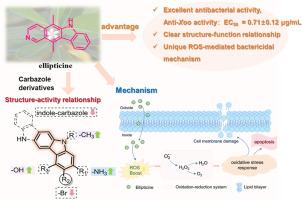新型活性氧诱导剂的天然产物再利用:椭圆及其类似物的杀菌谱和构效关系
IF 3.3
3区 农林科学
Q2 PLANT SCIENCES
引用次数: 0
摘要
开发靶向氧化应激诱导破坏细菌氧化还原防御的治疗剂已成为抗菌研究的重要策略。为了增加活性氧诱导剂的结构多样性以控制细菌感染,采用天然产物再利用策略,鉴定出植物源生物碱椭圆菌是一种具有抗水稻黄单胞菌作用的新型诱导剂。稻瘟菌感染水稻。值得注意的是,椭圆素对米黄单胞菌具有显著的抗菌活性。oryzae (EC50 = 0.71±0.12 μg/mL)较对照硫代二唑铜(TC, EC50 = 80.38±1.36 μg/mL)增强113倍。机制研究表明,ellipticine诱导细菌细胞内ROS爆发性爆发,引发细菌凋亡级联,损害细胞膜完整性。有趣的是,利用水稻模型进一步验证表明,椭圆素对细菌性叶枯病的保护和治疗效果分别为52.75%和47.26%,几乎是TC的两倍(保护率为28.55%,治愈率为26.47%)。此外,椭圆素表现出良好的类药物性质。这是第一个通过ros介导的杀菌机制提出椭圆素作为植物性杀菌剂的报道,为开发新的杀菌剂提供了一个重要的例子。本研究不仅弥补了理解天然产物开发中ROS介导的抗菌机制的重要空白,而且为针对ROS途径的抗菌分子的优化设计奠定了理论基础。本文章由计算机程序翻译,如有差异,请以英文原文为准。

Natural-product repurposing for novel reactive oxygen species inducer discovery: bactericidal profiling and structure-activity relationship of ellipticine and its analogs
The development of therapeutic agents targeting oxidative stress induction to disrupt bacterial redox defenses has become a prominent strategy in antimicrobial research. To augment the structural diversity of reactive oxygen species (ROS) inducers for bacterial infection control, it was implemented a natural product repurposing strategy, through which ellipticine—a plant-derived alkaloid—was identified as an innovative agent effective against Xanthomonas oryzae pv. oryzae infecting rice. Notably, ellipticine demonstrated significantly superior antibacterial activity against Xanthomonas oryzae pv. oryzae (EC50 = 0.71 ± 0.12 μg/mL) compared to the control thiodiazole copper (TC, EC50 = 80.38 ± 1.36 μg/mL), with enhancement of 113-fold. Mechanistic investigations revealed that ellipticine induced an explosive burst of ROS within bacterial cells, triggering the bacterial apoptotic cascade and compromising cell membrane integrity. Interestingly, validation using a rice model further demonstrated that ellipticine exhibited protective and curative effects against bacterial leaf blight at rates of 52.75 % and 47.26 %, respectively, nearly double those of TC (protection rate: 28.55 %; curative rate: 26.47 %). Additionally, ellipticine exhibited favorable drug-like properties. This is the first report proposing ellipticine as a botanical bactericide candidate via ROS-mediated bactericidal mechanism, providing a significant example for the development of new bactericides. This research not only bridges a critical gap in understanding ROS-mediated antibacterial mechanisms in natural product development but also lays a theoretical foundation for the optimal design of antibacterial molecules targeting the ROS pathway.
求助全文
通过发布文献求助,成功后即可免费获取论文全文。
去求助
来源期刊
CiteScore
4.30
自引率
7.40%
发文量
130
审稿时长
38 days
期刊介绍:
Physiological and Molecular Plant Pathology provides an International forum for original research papers, reviews, and commentaries on all aspects of the molecular biology, biochemistry, physiology, histology and cytology, genetics and evolution of plant-microbe interactions.
Papers on all kinds of infective pathogen, including viruses, prokaryotes, fungi, and nematodes, as well as mutualistic organisms such as Rhizobium and mycorrhyzal fungi, are acceptable as long as they have a bearing on the interaction between pathogen and plant.

 求助内容:
求助内容: 应助结果提醒方式:
应助结果提醒方式:


